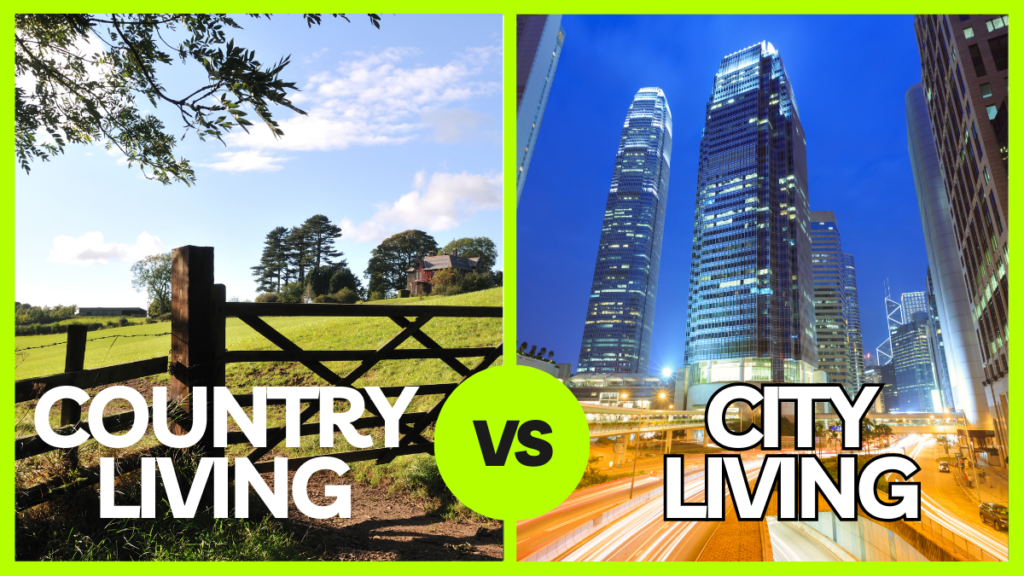Choosing country vs city living is tough today. Cities offer jobs and easy access to things, but rural areas have peace and big homes. Living in New York or Vermont shows how different these places can be.
City living costs more, has more crime, and is polluted. But, rural areas are calm, have strong communities, and are healthier. Your choice depends on what you value most: city life’s buzz or country’s quiet.

Introduction to Country vs City Living
When comparing country vs city living, the decision often comes down to personal lifestyle preferences. City dwellers benefit from the convenience of metropolitan amenities like abundant job opportunities, shopping, and entertainment options. However, the cost of city living is significantly higher, with expensive property prices and elevated daily expenses.
On the other hand, rural living offers a peaceful environment with more space and a slower pace of life. It’s also more affordable, with lower housing costs, reduced pollution, and cheaper overall living expenses. Despite these advantages, rural areas come with their own challenges, such as limited shopping options, fewer amenities, and the necessity of a car for longer commutes. Additionally, internet connectivity and phone signals can be less reliable in the countryside.
City life may be vibrant and fast-paced, but it also brings issues like traffic congestion and higher pollution levels. On the upside, cities generally provide better access to healthcare, public services, and a broader range of social activities. Ultimately, the choice between country vs city living depends on your priorities and what lifestyle factors matter most to you. Weighing the pros and cons of each option will guide you toward making the best decision for your lifestyle.
Advantages of City Living
City living has many benefits that draw people in. We’ll look at the main perks, like convenience, job chances, and culture.
Convenience and Accessibility
One big plus of city living is how easy it is to get things done. You can find shops, hospitals, and public transport easily. In 2019, 5% of Americans used public transport to get to work.
With good public transport, you don’t need a car. This makes getting around the city simple.
Diverse Job Opportunities
Another reason to live in a city is the job market. Cities are where big companies are, offering many career paths. For example, in San Francisco, property prices can be very high.
This shows how valuable city locations are. With so many businesses, you can find jobs in many fields.
Vibrant Culture and Social Scene
City living offers a vibrant cultural and social experience, with access to diverse events, museums, and a wide array of cuisines. The bustling atmosphere makes it easy to meet new people and participate in exciting activities.
Urban areas boast rich cultural scenes and a variety of social opportunities, making it simple to find friends and engaging pastimes. However, when weighing the differences between country vs city living, it’s important to consider factors like pace of life, cost, and personal priorities, so which is the right lifestyle for you?
Disadvantages of City Living
Urban life has its perks, but it also has downsides. One big issue is the high cost of living. Things like rent, groceries, and utilities cost more in cities than in rural areas. This can be tough on your wallet, especially if you’re watching your spending closely.
High Cost of Living
Living in a city can be expensive. For example, the authors of this article bought a 1,250 square foot home with an extra 300 square foot attic for about $230,000 in 2013. Now, similar homes cost even more. Plus, with over 40 restaurants, coffee shops, and bars nearby, your spending can add up quickly.
Increased Pollution and Traffic
City living means dealing with pollution and traffic. The crowded public transport and busy roads during rush hours lead to bad air quality. You might have to give up clean air and a peaceful place to live for the city’s hustle and bustle.
Higher Crime Rates
Crime rates are often higher in cities. The crowded and diverse nature of cities can lead to more crimes than in rural areas. Thinking about safety and crime is important when choosing to live in a city.
Advantages of Country Living
Living in the countryside offers many benefits not found in cities. You can enjoy a peaceful life, large homes, and a strong connection with nature. Let’s explore the main advantages of country living.
Peace and Tranquility
The countryside is known for its peace and quiet. Studies show that rural areas are much quieter than cities. This quiet helps reduce stress and improves mental health.
Country living is a great escape from city noise. It offers a slower pace of life, perfect for those seeking calm.
Closer Connection to Nature
Rural living means being closer to nature. You can easily explore hiking trails, forests, and more. This promotes physical activity and mental calm.
Research shows that spending time in nature boosts mental health. Living in the countryside lets you enjoy nature every day, benefiting your mind and body.
Larger and More Affordable Living Spaces
Country homes are spacious and often cheaper than city homes. Lower property prices in rural areas make living there more affordable. You can have bigger homes, yards, and even grow your own food.
Prices for healthcare and transportation are also lower in rural areas. This makes country living even more appealing.
Many people are discovering the joys of rural living, where a slower pace, fresh air, and a strong sense of community create a fulfilling lifestyle. In fact, there are 15 reasons why country life beats city life hands down, making the countryside an increasingly attractive option for those seeking peace and space without sacrificing quality of life.
Disadvantages of Country Living
Country living brings peace and quiet, but it comes with its own set of challenges. People living in rural areas face unique problems like rural accessibility issues, service isolation, and needing their own cars. These issues can greatly affect daily life, making it crucial for those thinking of moving to a rural area to consider these points.
Limited Access to Amenities
One big problem with rural living is the lack of nearby amenities. In cities, you can easily find what you need within a short distance. But in rural areas, you often have to travel far for basic things. This can make people feel isolated and is a major worry for about 75% of rural residents.
Isolation and Distance from Services
Rural living means feeling isolated. The distance to important services like healthcare, schools, and shops is a big issue. This can be a big problem, especially in emergencies or for those who need regular medical care. While many rural folks value their community, the distance to services is something to think about.
Necessity for Personal Transportation
Another big issue in rural areas is needing your own car. With few public transport options, people rely on their cars for everything. This can be expensive and take up a lot of time, affecting their quality of life. It’s important to think about how much you’ll need your car before moving to a rural area.
Cost of Living: City vs. Country
The cost of living changes a lot between cities and rural areas. This is a big factor in choosing where to live. Urban areas have higher incomes but also higher costs.
Bloomberg says urban areas have higher median household incomes than the national average. But, rural areas have about 4% less income. Also, urban areas have about 3% more families below the poverty line. This shows a big difference in income between cities and rural areas.
Housing costs are a big difference between cities and rural areas. For example, the median home cost in New York City is 72% higher than in Livingston, Montana. Rent prices in cities have also gone up since COVID-19, making it harder for city families to budget.
Here is a detailed contrast between urban and rural living expenses:
| Expense Category | Urban Areas | Rural Areas |
|---|---|---|
| Housing | High – Mortgage/Rent | Lower – Affordable Rates |
| Transportation | Public Transport/Bike-Sharing | Personal Vehicle – Higher Initial Cost |
| Childcare | Costly | 35% Less After Move |
| Entertainment & Dining Out | High Budget | 80% Reduced Spending |
| Groceries | Moderate to High | 10-20% Savings by Buying in Bulk |
Despite the savings in rural living, moving there can cost more at first. You might need to buy a car or set up a new home. But, people often save about 20% by moving to the country.
In the end, while city families might make more money, rural living is often cheaper. This can lead to less stress and a happier life.
Real Estate and Home Sizes
When comparing city real estate with the country housing market, there are significant differences in home sizes and trends. These differences can influence your decision-making process.
Urban Housing Market
The urban housing market is characterized by limited space. This results in smaller homes and higher prices. Urban households have higher average incomes of $71,578 annually.
They also spend more, with an average annual spending of $57,059. City real estate tends to offer less space. This leads to fewer homes with open floor plans.
This dynamic can necessitate exploring alternative financing options like jumbo mortgages. Higher costs in urban living are a factor. However, city living provides close proximity to amenities. This often results in homes selling at higher prices, affecting long-term financial planning.
Rural Real Estate Trends
The country housing market offers larger land plots and residences at more affordable rates. Rural households have an average gross income of $49,841 annually. They spend around $45,031 per year.
Home lots in rural areas are typically larger. This provides more space for amenities like playground sets and swimming pools. The affordability and spaciousness of rural living are highlighted in this comparison.
Rural real estate tends to appreciate at a higher rate compared to urban homes. For example, home values in Michigan’s rural areas appreciated at 24.3%. This is compared to 15.2% for urban homes. The higher appreciation rate indicates excellent potential for asset appreciation in the country housing market.
Rural areas often offer more safety and privacy. This promotes a tranquil living environment. By analyzing these trends and aspects, you can make a more informed decision about whether urban or rural living suits your lifestyle and long-term financial goals.
Job Opportunities in Urban vs. Rural Areas
Job opportunities differ a lot between cities and rural areas. This affects city and rural job markets. Knowing these differences helps you choose the right career path.
Urban Job Market Dynamics
Urban areas have a lively job market because of their big populations and many industries. About 88% of U.S. jobs are in big cities. This means more chances for jobs and lower poverty rates in cities.
Urban areas also see more development, growing by 15% from 2000 to 2010. This leads to more job opportunities in different fields.
Urban areas get more funding and resources, giving job seekers an edge. The U.S. added 850,000 jobs in June, showing urban job markets are recovering well. Cities have lots of jobs in leisure, hospitality, and government, which are growing fast.
Rural Employment Opportunities
Rural areas have fewer job options than cities but offer special benefits. Jobs in rural areas often focus on the community, with groups working together because of limited resources. These jobs are closely linked to local needs and resources.
But, rural areas face challenges like getting only 3% of U.S. philanthropic dollars. Yet, places like Nebraska and South Dakota are doing well, with unemployment rates down. Rural communities grow through partnerships, helping those looking for jobs outside cities.
Understanding both urban and rural job markets is key to finding the right job. It helps you decide where to look for work that fits your skills and interests.
Social Life and Community Engagement
Choosing between city life and rural living changes your lifestyle a lot. Cities buzz with social activities like cafes, art shows, and sports. They offer a chance to meet people from all walks of life, but it’s hard to build deep connections.
Rural areas, on the other hand, offer a closer, supportive community. Neighbors often join together, creating a strong sense of belonging. Yet, it can be tough for newcomers to fit in. Joining local events and volunteering helps.
Politics and money also differ between cities and rural areas. Cities tend to vote Democratic, while rural areas lean Republican. Cities have higher earnings, but both face similar poverty rates. Many in both places feel they can’t afford their dream lifestyle.
| Aspect | Urban | Rural |
|---|---|---|
| Social Engagement | High, with diverse events and cultural exchanges | High within local communities, but limited diversity |
| Community Bonds | Weaker, due to fast-paced lifestyles | Stronger, tight-knit communities |
| Networking Opportunities | Abundant, professional and personal | Limited, but more intimate |
| Income Per Worker | $49,515 | $35,171 |
| Poverty Rate | 17% | 18% |
Despite economic and political differences, both city and rural folks often feel misunderstood. In both places, socializing and networking are key to feeling connected and building a strong community.
Raising a Family: City vs. Country
Deciding where to raise a family is a big choice that affects your family lifestyle choices. Urban and rural areas each have their own pros and cons. Cities offer convenience and easy access to things, with good schools and cultural spots for kids.
City life is lively and full of things to do. Kids might spend lots of time at markets, parks, cafes, and in taxis. They get to meet people from all walks of life. But, cities can also be risky, with crime and police helicopters always around.
Finding the right school is a big deal in cities. Parents work hard to get their kids into good schools. Despite the challenges, city kids tend to be healthier than rural kids, thanks to more parks and gyms.
Rural areas offer a different kind of childhood, with lots of space and fresh air. Kids on farms spend a lot of time outside, which helps them stay calm and focused. They also get to grow up with less asthma and allergies. Being close to nature makes kids smarter and more creative, even when they move to cities.
It’s fascinating to see how different environments shape young minds and bodies. On the farm, children tend to have a stronger connection with nature, which fosters creativity and stress resilience. In contrast, urban settings offer diverse cultural experiences and educational opportunities that can also be incredibly enriching.
But, there’s a financial side to consider. Cities are often more expensive, which can stress families. Rural areas, on the other hand, are cheaper to live in, making life easier for families.
So, whether you choose the city or the countryside, it’s all about what you value most. Cities offer a rich, diverse life, while rural areas provide a peaceful, nature-filled upbringing. Each place shapes families in its own way.
Health and Wellness: Urban vs. Rural Living
Urban and rural living have different health benefits and challenges. The kind of lifestyle you choose affects your overall well-being.
Access to Medical Facilities
City folks have easier access to healthcare. They can get medical help quickly. But, city living can lead to more asthma, allergies, and depression.
Rural areas have fewer medical facilities, making it harder to get care. Yet, rural living can be healthier due to cleaner air and more physical activity. For example, in India, rural air pollution caused 75% of pollution-related deaths in 2015.
Environmental Factors
Environmental health is key in both urban and rural settings. Cities have more pollution, which worsens asthma and allergies. In India, 1.1 million deaths in 2015 were linked to urban air pollution.
City life also means more stress, leading to anxiety and mood disorders. Urban residents are 20% more likely to have anxiety and 40% more likely to have mood disorders than rural folks.
Rural living, on the other hand, offers a break from pollution and stress. Being close to nature improves sleep and mental health. Natural spaces, like oceans or lakes, can reduce psychological distress.
To learn more about the happiness impact of city, suburban, and rural living, check out HealthDay.
Making the Decision: How to Choose the Best Lifestyle for You
Choosing between city and country living depends on many important decision-making factors. These factors are based on your personal preferences and the urban vs rural benefits that fit your lifestyle.
First, think about how close you are to amenities. In cities, you can walk to shops and services. But in rural areas, you might need a car because public transport is scarce.
Next, consider the size of your property and outdoor spaces. City homes are often smaller with little outdoor area. But rural homes are bigger with lots of space for gardens and outdoor activities.
Also, think about pollution levels. Cities have more pollution, which can harm your health. But the countryside has cleaner air and water, which is better for your health.
Job opportunities are another key factor. Cities have many jobs in different fields. But rural areas might have fewer jobs, but they could be more specialized and appealing to those who like to work remotely.
Property costs are also important. City homes are expensive because they are in high demand. But rural homes are cheaper, offering more space for less money. Utility fees and taxes are also lower in rural areas.
Community feeling is another factor. Rural areas have a stronger sense of community because of their smaller populations. But city life can be more isolating, making it harder to find friends.
Commuting and internet access are also important. Cities have better public transport and internet. But rural areas have longer commutes and less reliable internet, but they offer a quieter life.
Finally, happiness levels vary between cities and countryside. More people in rural areas are happy, and fewer in cities feel stressed. This shows the mental health benefits of living in the countryside.
| Factor | City Living | Country Living |
|---|---|---|
| Proximity to Facilities | Nearby amenities | Requires transport |
| Property Size | Smaller spaces | Larger homes, gardens |
| Pollution Levels | Higher | Lower |
| Employment Opportunities | Diverse job market | Specialized roles |
| Property Costs | High | Affordable |
| Community Engagement | Lower | Higher |
| Commuting | Convenient | Longer commutes |
| Connectivity | Better networks | Limited |
| Happiness Levels | 25% happy | 31% happy |
Weighing these factors will help you make a choice that suits you. Think about what’s most important to you, like amenities, community, or peace and quiet. Make sure your choice makes you happy and supports your well-being.
Conclusion
Choosing between city and country living is a deeply personal decision. It depends on what you value and your situation. Both cities and rural areas have their own good and bad sides, making the choice complex.
City living, as Oxford University found, can make you healthier and happier. Cities offer jobs, cultural experiences, and good public transport. They are great for those who want convenience and to be connected.
On the other hand, rural living has its own benefits. It offers peace, nature, and big homes. But, it also has its challenges like fewer amenities and healthcare. The lack of mental health services is a big issue in rural areas.
When deciding, think about what you want and your future goals. Whether you prefer city life’s energy or the calm of the countryside, knowing the pros and cons helps. This choice is key to a happy and meaningful life, wherever you live.




